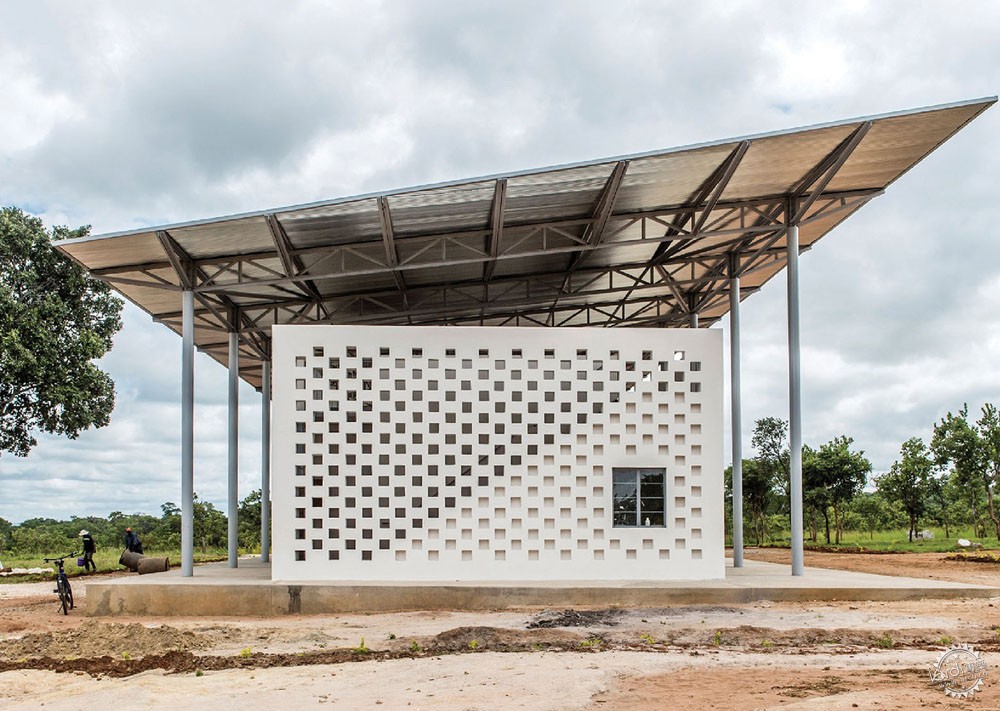
来自专筑编辑罗晓茜,刘庆新的报道。该项目Chipakata儿童学院是位于非洲赞比亚的一个新的小学,位于Chipakata村庄的场地位于赞比亚最大的城市卢萨卡以东大约100公里。它是由纽约市成立于2012年的非营利组织14 +基金会第一个项目。新学校的设计实现了基金会在非洲农村社区学校和孤儿院开发、建设和运营的任务。
From the architect. The Chipakata Children’s Academy is a new primary school in Zambia, Africa. It is the first initiative of the 14+ Foundation, a New York City-based non-profit organization established in 2012. The design for the new school has realized the Foundation’s mission to develop, build and operate schools and orphanages in rural African communities. The site in Chipakata Village is approximately 100 kilometers east of Lusaka, Zambia’s largest city.
© Rob Duker, Fabian Bedolla, Gord Ray and Joseph Mizzi
© Rob Duker, Fabian Bedolla, Gord Ray and Joseph Mizzi
© Rob Duker, Fabian Bedolla, Gord Ray and Joseph Mizzi
该项目位于一块平地上,东西方向都有群山环绕,所以这一地块在村里显得尤为重要。学校的建立使得该村子的孩子们大大缩减了每天走路上学的路程。在此之前,距离村庄最近的学校也有7公里。学院提供了一个全面的小学教育设施,为Chipakata村及周边社区的七个村庄提供儿童1 - 7年级的教育。该项目的第一阶段始于2015年1月,包括教学楼、社区馆、行政办公室和教师宿舍。附近农田用于生产食物,取得的收入支持学校的运作,确保项目长期在经济上实现可持续发展。当地村庄居民在整个开发和建设过程也充当了关键的参与者。
Situated on level topography with views to the surrounding hills east and west, the project defines a sense of place and community for the Village. Locating the school within the Village has dramatically reduced the distance the children must walk to school each day, as the nearest school is seven kilometers away. The Academy provides a comprehensive primary school education, grades 1-7, for children in seven villages in and around the Chipakata Village community. The first phase of the project, which opened in January 2015, includes a classroom building, community pavilion, administrative office and teachers’ housing. Nearby, agricultural fields dedicated to generating food and income support the operation of the school and ensure long-term economic sustainability for the project. Local village residents were key participants throughout the development and construction process.
© Rob Duker, Fabian Bedolla, Gord Ray and Joseph Mizzi
参照当地学校规划类型,教室结构的设计由标准模式转换为一种新的模式。和传统典型的四个教室相比,该设计提供了十个教学空间。这是通过打破典型的传统教室模式,引入集体活动的开放空间。此外,该建筑的屋顶遮蓬没有直接建立在围墙之上,而是抬高提高离开墙体,有楼梯通向高层,到达四个教室正上方的户外空间。在当地气候和太阳能的条件下,窗户开口和屋顶遮篷的安装都保证了白天进入教室的日光。天窗集中到所有教室,连续的挑檐保护了每层楼避免夏季猛烈的太阳直射。教学楼旁边是一个社区的聚会空间——一个三角形的结构,提供了一个躲避太阳和雨水的灵活空间,可以进行吃饭、聚会和社区庆祝等活动。
Referencing regional school planning typologies, the design of the classroom structure transforms the standard model to create a new paradigm. The design provides for ten teaching and learning spaces compared to the four rooms found in the typical prototype. This is achieved by breaking down the monolithic volume of the typical classroom bar building and introducing open space for collaborative activity between classrooms. Additionally, elevating the roof canopy above the masonry base allows for an upper level accessible by stair, with open-air spaces directly above each of the four classrooms. Informed by the local climate and solar conditions, the window openings and roof canopy are configured to maximize daylight within the classrooms. Clerestory windows are integrated into all the classrooms with a continuous roof overhang serving to protect spaces on both levels from harsh solar gain during the summer months. Adjacent to the classroom building is a community gathering space — a triangular shaped structure — providing shelter from the sun and rain and a flexible space for eating, gathering and community celebrations.
© Rob Duker, Fabian Bedolla, Gord Ray and Joseph Mizzi
© Rob Duker, Fabian Bedolla, Gord Ray and Joseph Mizzi
© Rob Duker, Fabian Bedolla, Gord Ray and Joseph Mizzi
Section/剖面图
该建筑教室的砖石结构和屋顶遮篷的重复结构建设基于模块化的方法。所有材料都是当地采购和现场组装。组合砌体结构的幕墙围合了建筑两端的楼梯。
The construction of the buildings is based on a modular approach to both the masonry units of the classrooms and the repetitive structure of the roof canopy. All materials were locally procured and assembled on-site. The textural quality of the unitized masonry construction is expressed in the screen walls that enclose the stairs at both ends of the building.
© Rob Duker, Fabian Bedolla, Gord Ray and Joseph Mizzi
© Rob Duker, Fabian Bedolla, Gord Ray and Joseph Mizzi
© Rob Duker, Fabian Bedolla, Gord Ray and Joseph Mizzi
© Rob Duker, Fabian Bedolla, Gord Ray and Joseph Mizzi
© Rob Duker, Fabian Bedolla, Gord Ray and Joseph Mizzi
© Rob Duker, Fabian Bedolla, Gord Ray and Joseph Mizzi
© Rob Duker, Fabian Bedolla, Gord Ray and Joseph Mizzi
© Rob Duker, Fabian Bedolla, Gord Ray and Joseph Mizzi
© Rob Duker, Fabian Bedolla, Gord Ray and Joseph Mizzi
© Rob Duker, Fabian Bedolla, Gord Ray and Joseph Mizzi
Section/剖面图
Solar Scheme/太阳能方案
Solar Scheme/太阳能方案
Diagram/图解
Diagram/图解
© Rob Duker, Fabian Bedolla, Gord Ray and Joseph Mizzi
建筑设计事务所:Ennead Architects
地点:赞比亚,卢萨卡
建筑师和施工经理:Fabian Bedolla
设计主创:Susan Rodriguez (Ennead Architects), Frank Lupo; Randy Antonia Lott.
建筑设计团队:Fabian Bedolla (on-site project architect), Hiroko Nakatani (Ennead Lab)
面积:20000.0 平方英尺
项目时间:2015年
摄影: Rob Duker, Fabian Bedolla, Gord Ray and Joseph Mizzi
设计团队:he project has been a collaboration of Design Principals who provided probono design services: Susan Rodriguez, FAIA, Ennead Architects; Frank Lupo, FAIA; Randy Antonia Lott and Nat Oppenheimer, Silman, Structural Engineers. Hiroko Nakatani, through Ennead Lab, was also a member of the team.
结构工程:Nat Oppenheimer (Silman)
施工经理:14+ Foundation, Inc. Joseph Mizzi (Sciame Construction), Fabian Bedolla (现场施工经理)
客户:14+ Foundation, Inc., New York, NY
场地面积:约100亩
Architects: Susan Rodriguez, Frank Lupo, Randy Antonia Lott
Location: Lusaka, Zambia
Design Principals: Susan Rodriguez (Ennead Architects), Frank Lupo; Randy Antonia Lott.
Architect Design Team: Fabian Bedolla (on-site project architect), Hiroko Nakatani (Ennead Lab).
Area: 20000.0 ft2
Project Year: 2015
Photographs: Rob Duker, Fabian Bedolla, Gord Ray and Joseph Mizzi
Structural Engineering: Nat Oppenheimer (Silman)
Construction Manager: 14+ Foundation, Inc. Joseph Mizzi (Sciame Construction), Fabian Bedolla (on-site Construction Manager)
Client: 14+ Foundation, Inc., New York, NY
Site Area: Approx. 100 acres
出处:本文译自www.archdaily.com/,转载请注明出处。
|
|
